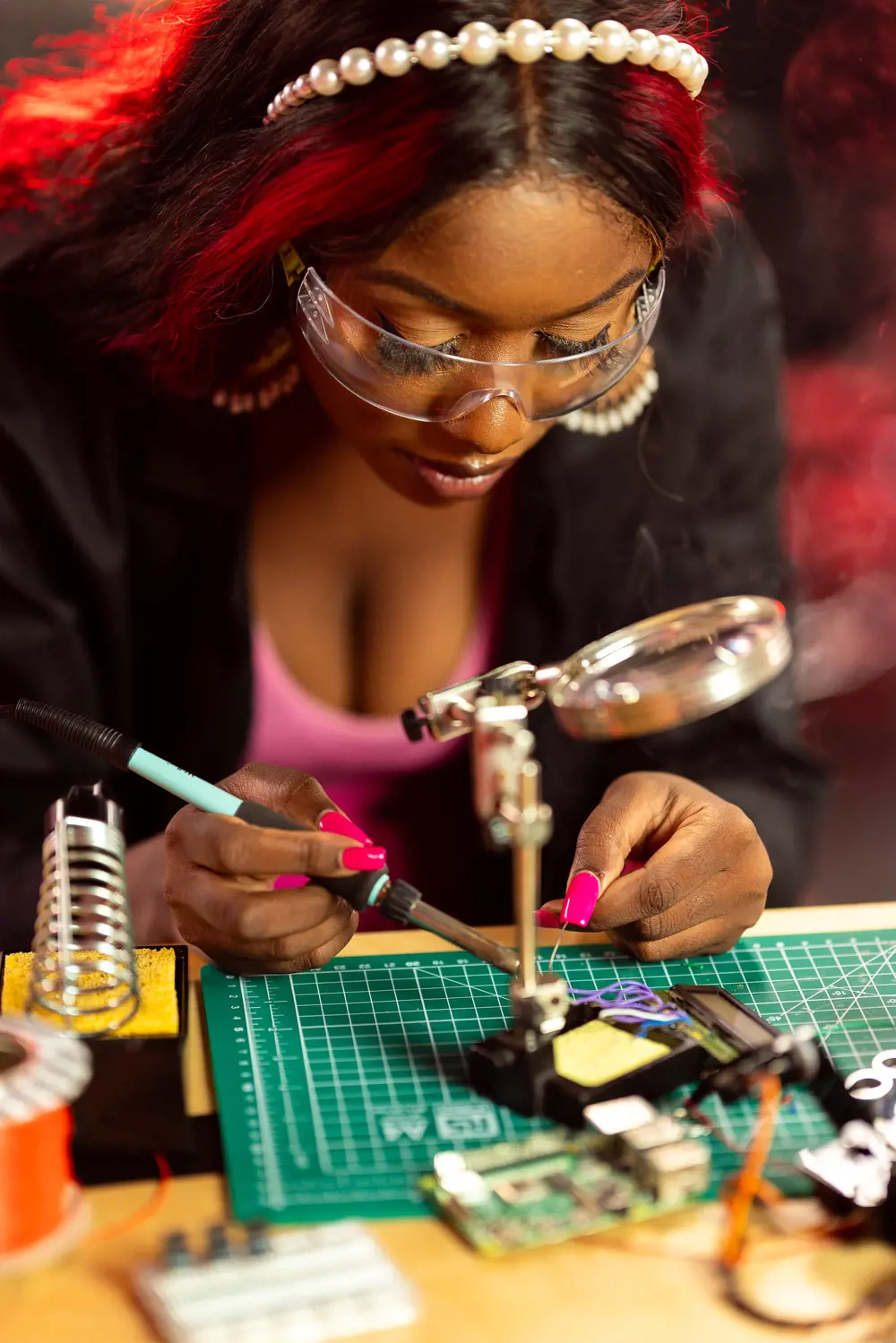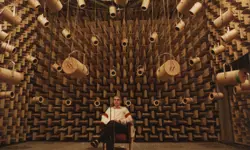
Q&A: Eneni Bambara-Abban, roboticist and technologist
Why did you become interested in science and engineering?
From a young age, I was always taking things apart, trying to understand how they worked. I didn’t really understand that at the time I was reverse engineering them. The kettle would go missing, and the toaster – and there I was tinkering about with them! When I was about five or six, we went to a flea market. There was this Black doll – and this was the 1990s, all the BABY borns were white. I was already excited just seeing a doll that looked like me – but it also had a speaker in it and could walk! I was so mesmerised. I remember thinking, what is this magic?
I didn’t know what kind of engineering made a doll like that possible, but I knew that I wanted to be a person who could build that. And later on, asking ‘Jeeves’ (an early search engine), we found out it was robotics. And thus started my journey into becoming a robotics engineer.
How did you get to where you are now?
At school, I did the sciences, maths, everything that you would advise somebody to do if they wanted to be an engineer. I applied to the best engineering schools but after college, didn’t get the grades in my A levels. Eager not to give up, I wrote a letter to the engineering department at the University of the West of England pleading with them and saying how I’d always wanted to be a robotics engineer, with an example of a robot I built. Thankfully, they offered me a chance to go on their [engineering] foundation course and after that I went onto my first year at uni.
University was very up and down, but [I] ultimately finished it after being inspired at the Young Women in Engineering awards. I was about to drop out. I was in my final year and it was so hard, especially being the only Black girl on my course. I often felt like I didn’t belong there.
Dr Shini Somara was at the awards the year I attended. Her speech was incredibly motivating – I felt like she was talking to me and telling me not to give up. So, I had a little prayer to God – if you help me finish this degree, I promise I will pay it forward and help get other girls into STEM. And then I graduated, and was like ‘oh dang, now I gotta keep my promise to God!’. Since then, I’ve been fighting for women’s equality and equity in the STEM industry.

Eneni in the robotics lab at The Engineering & Design Institute London (Tedi) © This is Engineering
What has been your biggest achievement to date?
In 2021, at the height of my engineering career, I had to deal with many microaggressions and sexism – all kinds of things. I remember feeling so defeated, like my purpose was to help others, and I didn’t feel like I was being respected or helping anyone.
I travelled back to Nigeria, [where] I did high school. I remember thinking I [could] have more impact there. I curated a workshop in collaboration with Arduino [an prototyping platform to build electronic devices] where I taught girls from northern Nigeria how to build their first robot, how to code, but really how to dream. They were all fascinated by the Arduinos – and I was very impressed by just how well they built the robots for their first attempt! So yeah, for me it was a very enlightening moment that propelled the birth of my NGO, The Techover Foundation.
What is your favourite thing about being an engineer?
The fact that you can think of something in your head and translate it into a real tangible thing in front of you. I just think that’s so amazing. Honestly, I see it as a superpower that anyone can have, as long as you’re passionate about engineering, and you stay curious.
What does a typical day involve for you?
No two days are the same for me. I have a few different jobs, the main one currently being creative technology manager for the British Council where I’m exploring how screen-based media, using new technologies from XR to AI, overlap and intersect with conventional art forms. I’m also a freelance robotics engineer working on custom projects for my varied clients. I also have a company called Anime and Chill where I run anime and gaming events in London to over 4,000 members, creating a safe space for those often marginalised within these industries.
Last but certainly not least, I run my NGO, the Techover Foundation. This year we have plans to go to the Philippines to advocate against child marriage and push for girls’ participation in STEM-specific education. There's a lot of things happening concurrently, so I always prioritise project management. Every day I have a mini meeting with myself to make sure I’m clear on my to-do list, otherwise things get very chaotic very quickly.
Quick-fire facts
👯 Eneni reckons the coolest roboticist out there is...
Age:
30
Qualifications:
Undergraduate degree in robotics; postgraduate degree in data science and artificial intelligence; scrum master (project management)
Biggest engineering inspiration:
Hiroshi Ishiguro, a robotics engineer at the University of Osaka. He was one of the first people to build a robot that looks exactly like him, down to the face, the mannerisms, the body language. I honestly think he’s one of the coolest people on the planet and who wouldn’t love to build their own robot twin!
Most-used technology:
Probably my probably my Raspberry Pi 4 and my laptop.
Three words that describe you:
Tenacious, inquisitive, empath.
What would be your advice to young people looking to pursue a career in engineering?
I've done pretty much anything and everything I've wanted to do – robotics, software engineering, computer vision. I’ve not really had the typical linear career where you start as an intern or junior and then you work your way up, and I like to think I turned out okay!
While you’re young, TRY IT ALL. The worst thing is being stuck in a career where you’re not fulfilled or you feel like you missed out on something else. Start building things at home outside of school or on the weekends. Try your hand at coding from a YouTube tutorial. Or maybe you’re not a fan of university and want something more practical? Well, consider looking into an apprenticeship!
Whatever type of engineer you want to be, is the type that you should be. There’s no rulebook. I have made it my mission to push the narrative that you don’t have to look one way or have a specific route into engineering to be an engineer and I truly believe it.
What’s next for you?
Our workshop in the Philippines is definitely a big one. I want to go into communities that I feel could really benefit from tech and show them they can do things that empower them. Before that, I’m doing an exhibition where I want to feature women, girls, and non-binary people working in STEM and doing amazing things.
My movie STEM is also in the works, which focuses on a diverse group of women thriving and flourishing in STEM. It’s a bit like Hidden Figures mixed with Girls Trip or Sex and the City. We’ve had talks with Channel 4, Netflix… things are getting exciting and we hope to increase entry and retention of women in STEM through our film.
***
Keep up-to-date with Ingenia for free
SubscribeRelated content
Electricals & electronics

Accelerometers
Used in earthquake measurements, laptops, planes and even in stargazing apps, today’s accelerometers are much smaller than when they were first developed in 1927. Find out how they detect movement and vibration.

How to maximise loudspeaker quality
Ingenia asked Dr Jack Oclee-Brown, Head of Acoustics at KEF Audio, to outline the considerations that audio engineers need to make when developing high-quality speakers.

Cable fault locator
The winner of the Institute of Engineering and Technology’s 2014 Innovation Award was EA Technology’s CableSnifferTM, which uses a probe and chemical sensing technology to identify faults, saving energy companies millions of pounds each year.

High speed evolution
In December 2010, Eurostar International Ltd awarded a contract for 10 new high speed trains to Siemens. The company has used a system developed over decades to maximise the performance and passenger-carrying ability of its 320km/h trains.
Other content from Ingenia
Quick read

- Environment & sustainability
- Opinion
A young engineer’s perspective on the good, the bad and the ugly of COP27

- Environment & sustainability
- Issue 95
How do we pay for net zero technologies?
Quick read

- Transport
- Mechanical
- How I got here
Electrifying trains and STEMAZING outreach

- Civil & structural
- Environment & sustainability
- Issue 95